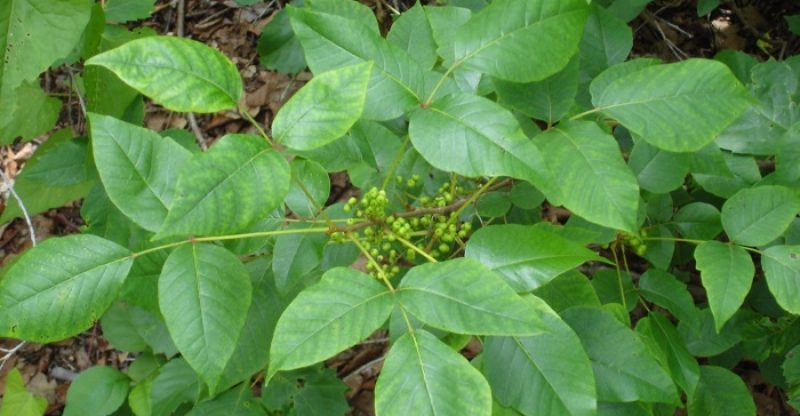8 Best Natural Treatments for Poison Ivy
While summertime may be the perfect season for spending time outdoors and communing with nature, it is also the best time for suffering from stings, bug bites and the horrible, itchy mess known as poison ivy.
Poison ivy, poison oak, and poison sumac can all cause painful, itchy, and embarrassing rashes, and learning how to take care of them at home, can help you feel and look better quickly.
Learning how to stay away from and prevent the spread of poison ivy is key to treating this rash, as is learning the at-home, natural remedies that work best for soothing the itchiness, calming the irritation, and healing your skin quickly.
However, what causes poison ivy anyway?
Why do some people react worse to this plant than others? Let’s find out.
The Basics of Poison Ivy
While none of us goes looking for poison ivy to frolic in each summer, it is not difficult to come into contact with this offending plant, if you spend any time in the woods or have large trees in your yard.
Learning how to identify poison ivy is especially important, and we’ll discuss prevention later.
How does poison ivy cause such a horrible rash? How does it even work?
Every leaf of poison ivy, oak, or sumac contains sap.
The sap of each of these is a chemical known as urushiol.
It can sit on top of the leaf’s surface so that when you walk or ride your bike by a plant and rub it with your ankles or legs, you can transfer the sap onto your skin.
Any body part that touches the fluid, can then transfer it onto other parts of your skin.
Within 10 minutes of contact, at least half the urushiol on your skin has already been absorbed.
Once absorbed, your body’s immune system will quickly identify this compound as an unwanted invader and respond with an allergic reaction in the affected area.
The sap inside the poison ivy plant comes to the surface, only when the plant itself is damaged.
However, since it is a delicate plant, damage can come from people merely walking by it, from animals, or from a strong wind.
Once on the surface, the heavy sap lingers, making it easy for the next passerby to come into contact with it.
The sap can stick to skin, clothing, pet fur, or gear, like shoes and backpacks.
So, you don’t have to touch a plant to get poison ivy.
Once your skin has come into contact with the sap, you have a very narrow window (less than 10 minutes) to wash it off with soap and water to prevent a rash from forming.
After that, the compounds are already in your system, and you will have to contend with the itchy, annoying rash that will follow.
Naturally Treating Poison Ivy
Because it doesn’t take long for a poison ivy reaction to begin, and because some people are more susceptible to developing a rash that spreads and becomes obvious, it is essential you know how to treat poison ivy at home.
The best treatments for this rash tend to be using natural ingredients, and with the right attention to your problem, you can start feeling better quickly.
The remedies you choose must neutralize the urushiol, lower the inflammation associated with a histamine reaction, draw the offending toxins from your skin and help calm the itching, so that you don’t scratch your rash.
Staying cool and keeping your skin calm while treating poison ivy is important.
Avoid eating spicy foods, taking overly hot showers, or spending time in direct sunlight.
All of these actions can cause your rash to remain inflamed and irritated.
Keeping your stress down will also help you combat your rash without making it worse.
Here are the best natural treatments for successfully getting rid of poison ivy.
Jewelweed
This first remedy may be the most effective but also among the hardest to find.
If you happen to notice the poison ivy plant shortly after touching it, you should start looking around for jewelweed.
This plant has chemical properties that neutralize poison ivy’s urushiol.
Native people long ago recognized this plant’s ability to stop the offending rash and treat poison ivy.
This plant also tends to grow near poison ivy.
The next time you are out in the woods and see poison ivy, look for a nearby plant with a tall stalk and silvery-green leaves.
If the flowers are in bloom, jewelweed’s will be orange or yellow and shaped like trumpets.
If you’ve already touched poison ivy that day and need a quick fix, break the stalk of the plant, chew it slightly, then rub the jewelweed sap directly onto the exposed skin to prevent a rash.
You should then pick the entire plant to take home with you to make an effective poison ivy treatment.
Chop up all parts of the plant, boil it in water for 30 minutes and then strain out the infused water, which should be bright orange.
You can make ice cubes from this infused liquid, which you can rub on poison ivy any time for quick relief.
Similarly, you can simmer the leaves and stems with coconut or olive oil, strain, then bottle the infusion to use as a soothing, poison ivy topical oil treatment.
Apple Cider Vinegar
Apple cider vinegar is effective for drawing out the toxins from a poison ivy rash, reducing inflammation and providing relief.
It is gentle enough to be used often, and you can apply it in several ways.
Use a cotton square or clean rag (never reuse clothes that have touched poison ivy without washing them first) to apply apple cider vinegar directly to the rash.
You can also use apple cider vinegar to dry out your rash quickly.
Start by lightly scrubbing your rash with a loofah.
Next, apply a paste of apple cider vinegar and baking soda to the rash, allowing it to sit for at least five minutes.
Rinse with cool water, then apply more plain apple cider vinegar to the rash, leaving it on the skin.
Store apple cider vinegar in a spray bottle in the refrigerator to spritz onto itchy skin when needed, as well.
Turmeric
You probably already have one of nature’s most potent anti-inflammatories right in your kitchen.
Turmeric not only lowers inflammation but is also a natural antibacterial, and together, these are effective for treating poison ivy.
To stop the itch, mix one tablespoon of powdered turmeric with lemon juice, vodka or rubbing alcohol to create a thick but spreadable paste.
Apply this directly to your poison ivy rash, being careful not to get this mixture on clothing or linens, as it will stain.
Allow it to sit for 20 minutes, then rinse with cool water. Repeat often for best results.
Herbal Tea
Many herbs have excellent properties for treating poison ivy.
Any herb that lowers inflammation can be used to treat poison ivy.
The best herbs include burdock root, comfrey, chamomile, and plantain.
To use herbal tea, select the herb of your choice, then make a strong infusion using twice as much tea or herbs as you would normally use for drinking.
Allow the infusion to cool, then create a compress by dipping a cloth into this liquid.
Place the compress over your rash for at least 10 minutes, then allow your skin to dry naturally without rinsing the tea away.
Aloe Vera
Aloe vera gel has been used to treat all sorts of skin disorders and rashes for generations.
Aloe is an excellent choice for treating poison ivy, and it can provide immediate relief from itching and irritation.
Simply snip an aloe leaf from the plant and squeeze the gel out onto your rash.
You can also store leaves in the refrigerator, giving you a cool gel to relieve severe irritation.
Aloe keeps your skin moisturized, too, which will help it to heal more quickly from poison ivy.
Witch Hazel
Another tried-and-true remedy for poison ivy is to use witch hazel.
This traditional treatment can help dry out your rash and relieve itching.
Spray or dab witch hazel directly onto the affected areas, as often as needed.
Oatmeal
If you have poison ivy, one of the best treatments you can use to prevent the spread of your rash and to calm irritated skin is oatmeal.
You can buy colloidal oatmeal to add to your bathwater, or you can make your own oatmeal bath.
A colloid is simply when tiny particles are suspended in a liquid.
You can achieve this with oatmeal, by grinding rolled oats with a high-speed blender, then adding water to create an oatmeal “slurry.”
Once you have your oatmeal, you can add it slowly to your bathwater, stirring constantly, as the tub fills.
Another effective remedy is to cook oatmeal as you normally would, then blend it until smooth.
Apply this paste to your rash and allow it to sit for at least 20 minutes. Rinse with cool water.
Epsom Salts
Epsom salts naturally treat skin disorders and issues, while also relieving itching.
Soak in a cool bath that has one to two cups of dissolved Epsom salts.
If you like, you can also combine this with the above treatment and add oatmeal to your Epsom salts bath.
How to Prevent Poison Ivy
The number one strategy for preventing poison ivy is to avoid it.
Learn what the plant looks like so that you can easily find it when you are outdoors.
Poison ivy can grow as a climbing vine attached to trees and other plants, as a shrub that grows up to 11 inches tall and as a trailing vine that is about 10 inches tall.
All species are known for their almond-shaped leaflets that grow in groups of three.
Each leaflet on a plant has few or no teeth along the edge.
The surface of the leaf is smooth and light to dark green in color.
If the sap is visible on the leaves, it will be milky white (if fresh) or black-ish (if older).
If you do encounter a poison ivy plant or its sap, your next best defense is to wash the area at once with soap and water.
Cleansing the area immediately will keep the oils from soaking into the skin and causing the allergic reaction.
Around 70 percent of the population has some sort of allergic reaction to poison ivy, varying from mild to severe.
Other people have no reaction to the urushiol, making them incredibly lucky individuals!
Try to avoid touching other objects or people, if you know you have touched poison ivy sap with your hands.
This will help prevent the spread of the allergens to others.
Wash all clothing that was exposed to poison ivy in plenty of cold water, with a good amount of detergent.
Urushiol can remain on surfaces for a long time.
Therefore, be sure to avoid touching anything you possibly can with affected skin or clothing.
Clean your washing machine, sink and anything else you touched, if you fear you were exposed to poison ivy.
If pets are outdoors in areas where poison ivy is common, they should be bathed often, as should their bedding.
The oils can remain on their fur for weeks or even months.
Therefore, if you are experiencing repeated rashes despite no new trips to the outdoors, your furry companion may be to blame.
Conclusion
Poison ivy may not be life-threatening, but it can be a nuisance that causes pain, itching, and irritation for several days to several weeks.
Those who are highly allergic to the compounds in poison ivy can attest that finding a natural treatment that works quickly and easily is necessary and welcome.
You can use common household items to help treat your poison ivy, including apple cider vinegar, herbal teas, witch hazel, Epsom salts, oatmeal, turmeric, and aloe vera.
Using natural anti-inflammatories will help treat the offending allergic reaction.
Keeping skin soothed will prevent scratching, which can lead to a secondary infection.
Preventing an outbreak or spread of poison ivy will be your most important defense against this skin disorder.
Know what the plant looks like, avoid it at all costs and wash any affected areas at once, with soap and water.
FDA Compliance
The information on this website has not been evaluated by the Food & Drug Administration or any other medical body. We do not aim to diagnose, treat, cure or prevent any illness or disease. Information is shared for educational purposes only. You must consult your doctor before acting on any content on this website, especially if you are pregnant, nursing, taking medication, or have a medical condition.
HOW WOULD YOU RATE THIS ARTICLE?






